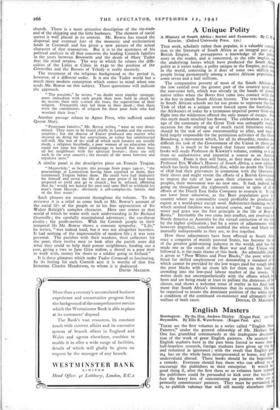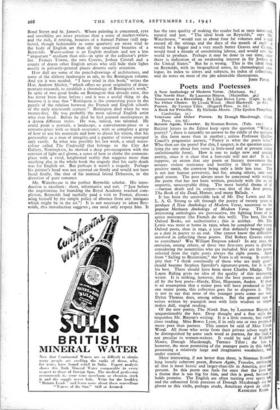English Masters
31s. 6r1
'THESE are the first volumes in a series called "English Mast Painters:' under the general editorship of Mr. Herbert R One has grumbled continuously at the inadequate documen tion of the work of great English painters. On account of English students have in the past been forced to waste time half-hopeless research, foreign students have given up the fi and remained in ignorance ; with the result that English p ing has on the whole been misrepresented at home, and gr undervalued abroad. These books should be the beginning a remedy. Everyone should buy them who can afford to, encourage the publishers in their enterprise. It would be good thing if, after the first three or so volumes have appe the publishers could be persuaded to kick over the traces face the heavy loss of concentrating on painters who are primarily connoisseurs' painters. They must be persuaded, is, to publish volumes that will sell mainly elsewhere than
Bond Street and St. James's. Where painting is concerned, eyes and sensibility are more precious than a sense of market-values, and the rich, if retiring, beauties of a Samuel Palmer (still neg- lected, though fashionable in some quarters) are more vital to the body of English art than all the senatorial beauties of a Reynolds. Water-colour is an English medium and not a less " important " medium than oils—in spite of the collector's price- list. Francis Towne, the two Cozens, Joshua Cristall and a couple of dozen other English artists who still hide their lights mostly in privately-printed places deserve early attention.
How dull are some of the pencil-drawings of architecture, and some of the slithery landscapes in oils, in the Bonington volume. And yet it was needed. "I have tried in this book," writes the Hon. Andrew Shirley, "which offers no great originality of docu- mentary-research, to establish a chronology of Bonington's work." In spite of two good books on Bonington that already exist, this has never been done before ; and it was a useful thing to do, because it is true that "Bonington is the connecting piece in the puzzle of the relation between the French and English schools of the early nineteenth century." Bonington died when he was twenty-five. He was probably the most talented English artist who ever lived. Before he died he had painted masterpieces in a dozeib different styles. He was, indeed, too talented. He could paint a portrait, a landscape, a conversation-piece or a costume-piece with so much assurance, with so complete a grasp of how to use his materials and haw to direct his vision, that his personality as a man of integrity.and a painter of vision emerged only rarely. In what was possibly his last work, a small water- colour called The Undercliff that belongs to the City Art Gallery, Nottingham, he showed a deep pre-occupation with the contrast of light and gloom, a sense of how to clothe the common- place with a vivid, heightened reality that suggests more than anything else in the whole book the tragedy that his early death was for English art. But perhaps it wasn't a tragedy. Perhaps his painter's head was not screwed on firmly and would not have faced finally, like that of his inimical friend Delacroix, in the direction of pure romance.
Mr. Waterhouse is the perfect Reynolds scholar. His intro- duction is excellent: short, informative and tart. (" Just before the negotiations for founding the Royal Academy reached com- pletion, Reynolds had tactfully paid a visit to France, dissoci- ating himself by the simple policy of absence from any intrigues which might be in the air.") It is not necessary to adore Rey- nolds, this introduction suggests ; one need only respect him. It
has the rare quality of making the reader feel at once interested, natural and just. "The ideal book on Reynolds," says Mr. Waterhouse' "would run to about four fat volumes and would record all the sittings and the days of the month of each • would be a bigger and a very much better Graves and Cranin, would need a decade of unremitting labour, and would cost the world to produce. Perhaps it may be done in our time, nine there is indication of an awakening interest in Sir Joshua in the United States." But he is wrong. This is the ideal book on Reynolds, with its biographical notes, its chronological cata- logue, its index to sitters and subjects, its index of collections, and its notes on most of the 360 admirable illustrations. Jam PIPER.



























 Previous page
Previous page